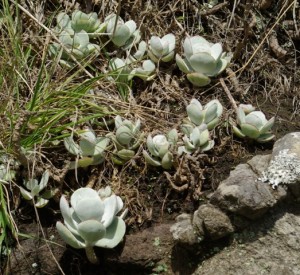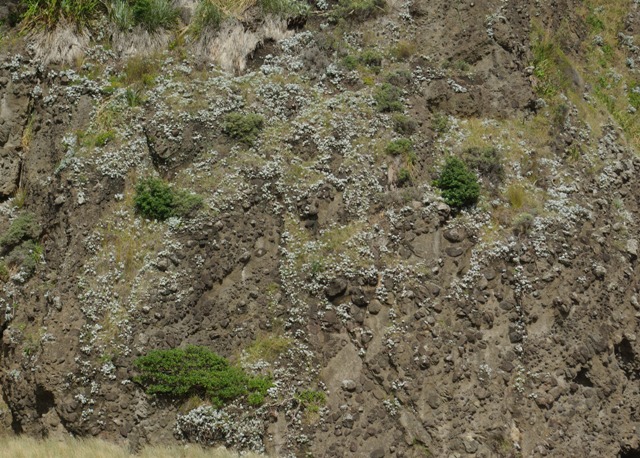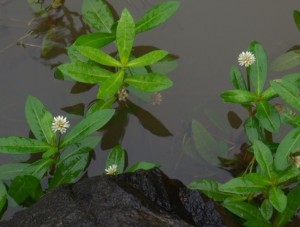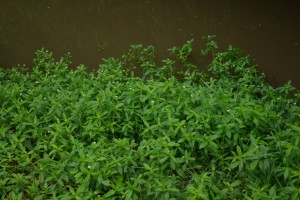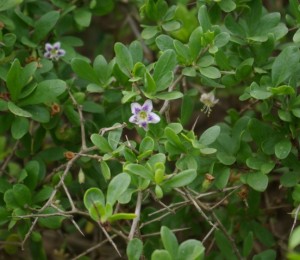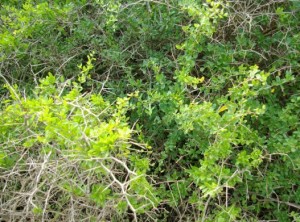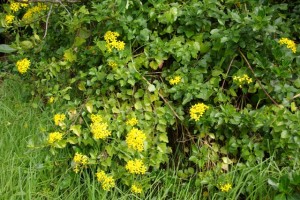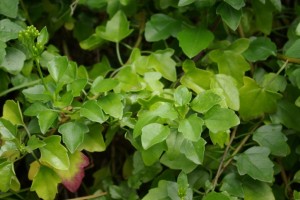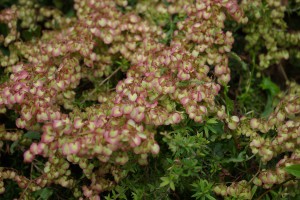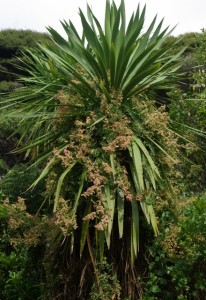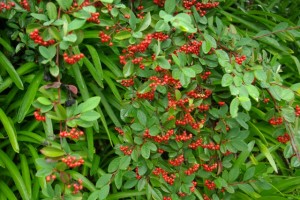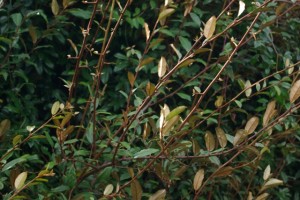African Pig’s Ear
Cotyledon orbiculata
If you visit Anawhata you will be struck by the silvery-grey succulent on the cliff faces. This plant was orginally planted by Sally Parker, of Keddle House, sometime in the 1930s or 1940s when Sally was a mad keen gardener.
Now, 70 years later, Sally’s pretty little succulent has taken over cliff faces, and can be found as far afield as Piha.
Like a lot of South African imports, African pig’s ear thrives in in its new home, but it has taken over the cliff faces and out-competes our native astelias and herb field plants. It has opposite silvery fleshy leaves with reddish edges, and produces clusters of reddish bell-shaped flowers on long stalks in summer. Seeds are dispersed by wind and gravity.
African pig’s ear is a Surveillance plant in the Regional Pest Management Strategy which means you cannot plant, sell or display. As it has invaded steep coastal cliffs this is not something for locals to tackle, but if you see it in your garden or a garden near you, dig it out and bin it.
Alligator Weed
Alternanthera philoxeroides
Considered one of the world’s worst weeds, Alligator Weed is an aquatic plant hailing from South America that forms dense mats in waterways and wetlands, including salty estuaries and dune lakes. It even grows in pasture.
At Piha there was an infestation at the Marawhara Stream, near the North Piha Campers Club which was controlled about 8 years ago. Now it is back and it is also in the Wekatahi and the Lily Pond.
It has bright green leaves and white, ball-like clover-type flower heads
It is fast growing – can double in area in two months – and forms new colonies from broken pieces of stem that can be spread by people, boats and I imagine by the ducks that are in all waterways at Piha. It clogs waterways causing flooding and sedimentation.
Controlling Alligator Weed is a job for the biosecurity team at Auckland Council and for the professionals. Spraying over water may require a resource consent and requires frequent follow up. Manual removal by digging out roots can be attempted in small areas but would require great care and vigilant follow up.
Alligator Weed is a Surveillance Pest Plant in the Auckland Regional Pest Management Strategy which means it can’t be grown, spread or sold. It is in the National Pest Plant Accord.
Boxthorn
Lycium ferocissimum
A spiney, scrambling woody evergreen bush which grows to about metre and aggressively invades exposed coastal areas including sand-dunes.
It has light green oval leaves and and small mauve and white flowers, a bit like miniature banana passionfruit vine flowers, appear from July to March. The orange/red berries that follow are poisonous and are readily spread by birds.
Like many other plant pests that trouble Piha, boxthorn comes from South Africa.
At Piha it was eventually eliminated on Lion Rock but there is quite an infestation on Marine Parade North in the Little Lion Rock area by the lagoon.
It can also sometimes be found in the dunes at North Piha.
Small seedlings can easily be hand pulled.
It is best to cut the trunks of large bushes and stump paint 200ml Glyphosate to 1 litre water or spray November to April with 100ml to 10litres water Glyphosate (do not use penetrant).
Boxthorn is a Surveillance Plant in the Regional Pest Management Strategy which means it can’t be sold, distributed or planted.
Cape Ivy
Senecio angulatus
Cape ivy is a particularly nasty weed species found all over Piha on the edges of roads and on properties. The leaves of this plant are uniformly mid-green, fleshy and, as the name suggests, shaped like ivy. The stems are fleshy and there are trusses of bright yellow flowers in the winter.
The dense, heavy plant smothers everything at ground level and on banks and can grow up to two metres over shrubs and trees.
Although removing a clump of cape ivy can look daunting, it’s a better prospect that some of Piha’s other weed species.
Best approach is to cut or slash the growth down to ground level and spray any regrowth. The mounds of plant removed can be spread out on open ground to dry so that it can be broken down.
The spray to use is Tordon Brushkiller during the plants period of active growth. The strength is 60 ml Brushkiller plus 10 mls Pulse penetrant to 10 litres of water. Read the spray instructions carefully and keep away from native plants.
I have also had good success spraying cape ivy with Grazon and Pulse penetrant. I have had to go back and do a second spray but this is quite successful with accessible infestations.
One way to help prevent spray drift is to attach a hood-shaped device to the spray nozel. This can be improvised from a large, light plastic flower pot or plastic kitchen storage container.
You poke or drill a hole in the bottom of the container if it does not have one, insert the spray wand through the hole and screw the nozzle back on. You may have to experiment to get this right.
This way you can pass the spray over unwanted plants with the plastic shield almost touching the plants and you can spot spray areas of regrowth.
Climbing dock
Rumex sagittatus
There is a huge infestation of clumbing dock on the corner of Seaview and Pendrell Road and it’s spreading.
I have lot of experience of this plant having eventually got rid of it in the stream gully at Beach Valley Road just below Sylvan Glade. I tried spraying it, and the above-ground growth would disappear. But it would resprout as the tubers and rhizomes were unaffected. Eventually I found that the best way was to find these in the soil and dig them out. After a few years I beat this infestation.
Climbing dock is a low climbing perennial that smothers natives. The reddish stems can be around 3-metres long and the green leaves are shaped like arrow-heads.
The prolific panicles of greenish or reddish flowers appear November to March and are followed to masses of seed heads that are very light and can be blown quite some distance.
Climbing dock thrives in disturbed areas, coastal locations and roadsides and can scramble 3-4 metres up trees.
If you try spraying, the mixture is 100ml glyphosate and 20 ml penetrant to 10 litres of water. Always read spray instructions carefully. However, if the infestation is not too extensive, I would track the stems back to the tubers and dig them out, then monitor regrowth and keep removing.
Cotoneaster
Cotoneaster glaucophyllus C.franchetii
These shrubs can look like a native, but the abundant red berries in autumn give them away.
Cotoneaster is a spreading shrub with long arching branches that can be found in many places, especially road sides around Piha.
The leaves are shiny and green but greyish on the underside. The flowers are white and fairly inconspicuous. They appear from October to January. The most spectacular and recognisable feature of cotoneaster is the plethora of brilliant red berries that appear from February to August. You can imagine how much the birds love these and spread them around.
Cotoneaster is a Surveillance Pest Plant, which means you cannot propagate, sell, display or distribute plants. You are encouraged to get rid of this plant if you have them in your garden.
Fortunately, they are one of the easier pest plants to get rid of. You can pull seedlings. The best method for shrubs is to saw off at the base and paint the stump with Vigilant Gel. You could spray the whole plant, but it is much easier to use a spoonful of Vigilant than to spray.
Elaeagnus
Originally used as a hedging plant this vigorous climber has colonised the area around Waiatarua (there is a big growth opposite the start of the Piha Road) and made inroads into the watershed area of the Waitakere Ranges. Elaeagnus can climb up the tallest kanuka, ponga or cabbage tree and kills its hosts by smothering them or toppling them with its weight.
It has long aggressive red-brown woody stems and leathery green leaves, with a light reddish-cream underside. The small bell-shaped flowers are cream with brown spots and appear in later summer.
There is no longer very much if any eleagnus at Piha. An area on the south-eastern corner of Te Ahuahu Road was removed and replanted by the Auckland Regional Council as a demonstration project a few years ago, and another area on the Piha Road has recently been treated.
Elaeagnus is difficult to remove. The plants need to be felled by slashing or chainsawing then the stumps painted liberally with herbiside before covering with plastic orsacking to shut out the light. Escort is used to deal with any regrowth.



